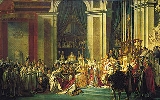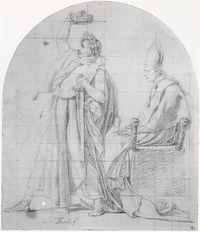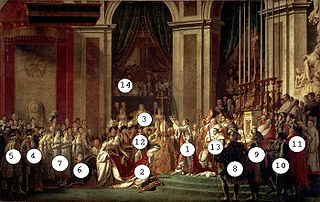
The Coronation of Napoleon
Encyclopedia
The Coronation of Napoleon is a painting completed in 1807 by Jacques-Louis David
, the official painter of Napoleon.
The painting has imposing dimensions, as it is almost ten metres wide by approximately six metres tall. The crowning and the coronation
took place at Notre-Dame de Paris, a way for Napoleon to make it clear that he was a son of the Revolution
.
started work on 21 December 1805 in the former chapel of the College of Cluny, near the Sorbonne
, which served as a workshop. Assisted by his student Georges Rouget
, he put the finishing touches in November 1807. From 7 February to 21 March 1808, the work was exhibited at the Salon annual painting display in 1810, and it was presented to the decennial prize competition. The painting remained the property of David until 1819, when it was transferred to the Royal Museums, where it was stored in the reserves until 1837. Then, it was installed in the Chamber Sacre of the museum of the historical Palace of Versailles on the orders of King Louis-Philippe. In 1889, the painting was transferred to the Louvre
from Versailles and replaced there with a full-size replica - this replica had been begun by David himself in 1808 and completed during his exile in Brussels
.
 The composition is organised around several axes, and incorporates the rules of neoclassicism
The composition is organised around several axes, and incorporates the rules of neoclassicism
. One axis is that which passes through the cross and has a vertical orientation. All eyes are turned towards Napoleon, who is the center of the composition. A diagonal line runs from the pope
to the empress.

Jacques-Louis David
Jacques-Louis David was an influential French painter in the Neoclassical style, considered to be the preeminent painter of the era...
, the official painter of Napoleon.
The painting has imposing dimensions, as it is almost ten metres wide by approximately six metres tall. The crowning and the coronation
Coronation of Napoleon I
The coronation of Napoleon I as Emperor of the French, which took place on Sunday December 2, 1804 , has been said to mark "the instantiation of modern empire", representing "transparently masterminded piece of modern propaganda"...
took place at Notre-Dame de Paris, a way for Napoleon to make it clear that he was a son of the Revolution
French Revolution
The French Revolution , sometimes distinguished as the 'Great French Revolution' , was a period of radical social and political upheaval in France and Europe. The absolute monarchy that had ruled France for centuries collapsed in three years...
.
History of the work
The work was commissioned by Napoleon orally in September 1804 and its official title is Consecration of the Emperor Napoleon I and Coronation of the Empress Josephine in the Cathedral of Notre-Dame de Paris on 2 December 1804. Jacques-Louis DavidJacques-Louis David
Jacques-Louis David was an influential French painter in the Neoclassical style, considered to be the preeminent painter of the era...
started work on 21 December 1805 in the former chapel of the College of Cluny, near the Sorbonne
Sorbonne
The Sorbonne is an edifice of the Latin Quarter, in Paris, France, which has been the historical house of the former University of Paris...
, which served as a workshop. Assisted by his student Georges Rouget
Georges Rouget
Georges Rouget was a neoclassical French painter.- Life :After studying in the école des beaux-arts, Rouget entered David's studio in 1797 and rapidly became his favourite student...
, he put the finishing touches in November 1807. From 7 February to 21 March 1808, the work was exhibited at the Salon annual painting display in 1810, and it was presented to the decennial prize competition. The painting remained the property of David until 1819, when it was transferred to the Royal Museums, where it was stored in the reserves until 1837. Then, it was installed in the Chamber Sacre of the museum of the historical Palace of Versailles on the orders of King Louis-Philippe. In 1889, the painting was transferred to the Louvre
Louvre
The Musée du Louvre – in English, the Louvre Museum or simply the Louvre – is one of the world's largest museums, the most visited art museum in the world and a historic monument. A central landmark of Paris, it is located on the Right Bank of the Seine in the 1st arrondissement...
from Versailles and replaced there with a full-size replica - this replica had been begun by David himself in 1808 and completed during his exile in Brussels
Brussels
Brussels , officially the Brussels Region or Brussels-Capital Region , is the capital of Belgium and the de facto capital of the European Union...
.
Composition

Neoclassicism
Neoclassicism is the name given to Western movements in the decorative and visual arts, literature, theatre, music, and architecture that draw inspiration from the "classical" art and culture of Ancient Greece or Ancient Rome...
. One axis is that which passes through the cross and has a vertical orientation. All eyes are turned towards Napoleon, who is the center of the composition. A diagonal line runs from the pope
Pope
The Pope is the Bishop of Rome, a position that makes him the leader of the worldwide Catholic Church . In the Catholic Church, the Pope is regarded as the successor of Saint Peter, the Apostle...
to the empress.
Characters

- Napoleon INapoleon INapoleon Bonaparte was a French military and political leader during the latter stages of the French Revolution.As Napoleon I, he was Emperor of the French from 1804 to 1815...
(1769–1821), is standing, dressed in coronation robes similar to those of Roman emperors. Others are merely passive spectators. - Joséphine de BeauharnaisJoséphine de BeauharnaisJoséphine de Beauharnais was the first wife of Napoléon Bonaparte, and thus the first Empress of the French. Her first husband Alexandre de Beauharnais had been guillotined during the Reign of Terror, and she had been imprisoned in the Carmes prison until her release five days after Alexandre's...
(1763–1814), is kneeling in a submissive position, as called for in the French Civil Code. She received the crown from the hands of her husband, not the pope. Her robe is decorated with silk according to a contemporary cartoon by Jean-Francois Bony. - Maria Letizia Ramolino (1750–1836), mother of Napoleon, was placed in the stands by the painter. She occupies a place more important than the pope. Actually, she did not attend the ceremony to protest the friction of Napoleon with his brothers LucienLucien BonaparteLucien Bonaparte, Prince Français, 1st Prince of Canino and Musignano , born Luciano Buonaparte, was the third surviving son of Carlo Buonaparte and his wife Letizia Ramolino....
and Joseph. Napoleon's father, Charles Bonaparte, died in 1785. Maria Letizia asked the painter to give it a place of honor. In 1808, when Napoleon discovered the canvas completed in the workshop of David, he was transported, and said his gratitude to the painter who had managed to pay tribute to posterity to the affection he was carrying a woman who shared with him the burden of his office. - Louis BonaparteLouis BonaparteLouis Napoléon Bonaparte, Prince Français, Comte de Saint-Leu , King of Holland , was the fifth surviving child and the fourth surviving son of Carlo Buonaparte and Letizia Ramolino...
(1778–1846), who at the beginning of the empire received the title of grand constable, King of Holland, in 1806. He married Hortense de BeauharnaisHortense de BeauharnaisHortense Eugénie Cécile Bonaparte , Queen Consort of Holland, was the stepdaughter of Emperor Napoleon I, being the daughter of his first wife, Joséphine de Beauharnais. She later became the wife of the former's brother, Louis Bonaparte, King of Holland, and the mother of Napoleon III, Emperor of...
, the daughter of Josephine. - Joseph BonaparteJoseph BonaparteJoseph-Napoléon Bonaparte was the elder brother of Napoleon Bonaparte, who made him King of Naples and Sicily , and later King of Spain...
(1768–1844), who was not invited and did not attend because of an argument with Napoleon. This is why his mother did not attend either. After the coronation, he received the title of imperial prince. Then he was king of Naples in 1806 and Spain in 1808. - The young Napoleon Charles BonaparteNapoleon Charles BonaparteNapoleon Charles Bonaparte was the eldest son of Louis Bonaparte and Hortense de Beauharnais. His father was the younger brother of Emperor Napoleon I and his mother was the daughter of Josephine de Beauharnais, Napoleon's first wife. At the time of his birth his uncle was First Consul of France...
(1802–1807), son of Louis BonaparteLouis BonaparteLouis Napoléon Bonaparte, Prince Français, Comte de Saint-Leu , King of Holland , was the fifth surviving child and the fourth surviving son of Carlo Buonaparte and Letizia Ramolino...
and Hortense de BeauharnaisHortense de BeauharnaisHortense Eugénie Cécile Bonaparte , Queen Consort of Holland, was the stepdaughter of Emperor Napoleon I, being the daughter of his first wife, Joséphine de Beauharnais. She later became the wife of the former's brother, Louis Bonaparte, King of Holland, and the mother of Napoleon III, Emperor of...
. - The sisters of Napoleon. In the replica, the dress of Napolean's favorite sister will be pink. This is the only change in the replica despite being painted from memory.
- Charles-Francois Lebrun (1739–1824), the third consul alongside Napoleon and Cambacérès. Under the First EmpireFirst French EmpireThe First French Empire , also known as the Greater French Empire or Napoleonic Empire, was the empire of Napoleon I of France...
, he took the place of prince-architrésorier. He holds the sceptreSceptreA sceptre is a symbolic ornamental rod or wand borne in the hand by a ruling monarch as an item of royal or imperial insignia.-Antiquity:...
.
- Jean Jacques Régis de CambacérèsJean Jacques Régis de CambacérèsJean-Jacques-Régis de Cambacérès, 1st Duke of Parma was a French lawyer and statesman during the French Revolution and the First Empire, best remembered as the author of the Napoleonic code, which still forms the basis of French civil law.-Early career:Cambacérès was born in Montpellier, into a...
(1753–1824), arch-chancellor prince of the empire. He takes the hand of justice. - Louis-Alexandre Berthier (1753–1815), minister of war under the Consulate. Marshal Empire in 1805. He keeps the globe surmounted by a cross.
- Talleyrand (1754–1836), grand chamberlain since July 11, 1804.
- Joachim MuratJoachim MuratJoachim-Napoléon Murat , Marshal of France and Grand Admiral or Admiral of France, 1st Prince Murat, was Grand Duke of Berg from 1806 to 1808 and then King of Naples from 1808 to 1815...
(1767–1815), marshal of empire, king of Naples after 1808, brother-in-law of Napoleon and husband of Caroline BonaparteCaroline BonaparteMaria Annunziata Carolina Murat , better known as Caroline Bonaparte, was the seventh surviving child and third surviving daughter of Carlo Buonaparte and Letizia Ramolino and a younger sister of Napoleon I of France...
. - Pope Pius VIIPope Pius VIIPope Pius VII , born Barnaba Niccolò Maria Luigi Chiaramonti, was a monk, theologian and bishop, who reigned as Pope from 14 March 1800 to 20 August 1823.-Early life:...
(1742–1823), was content to bless the coronation. He is surrounded by dignitaries clerics, appointed by Napoleon since the Concordat. In order not to jeopardize the new balance between Church and State, the pope accepted to attend the coronation. - The painter Jacques-Louis DavidJacques-Louis DavidJacques-Louis David was an influential French painter in the Neoclassical style, considered to be the preeminent painter of the era...
is depicted in the stands as well. - Halet EfendiHalet EfendiMohamed-Sayd Halet Effendi was a Ottoman Empire Foreign Minister and ambassador to Paris from 1802 to 1806. He was still ambassador to the court of Napoleon I in 1806...
, an Ottoman ambassador, was also present. He is shown below in the detailed picture.

